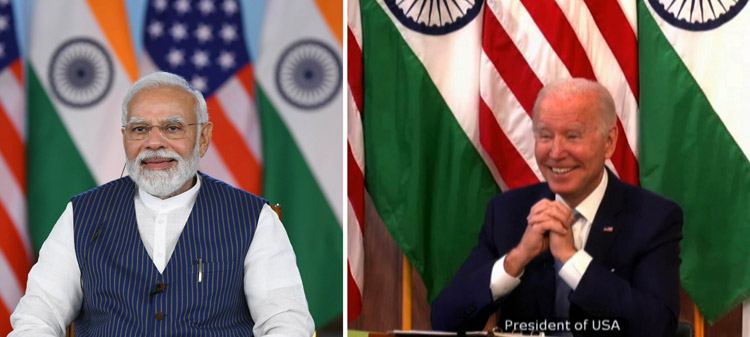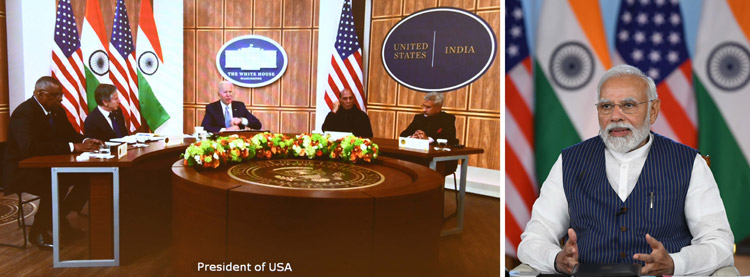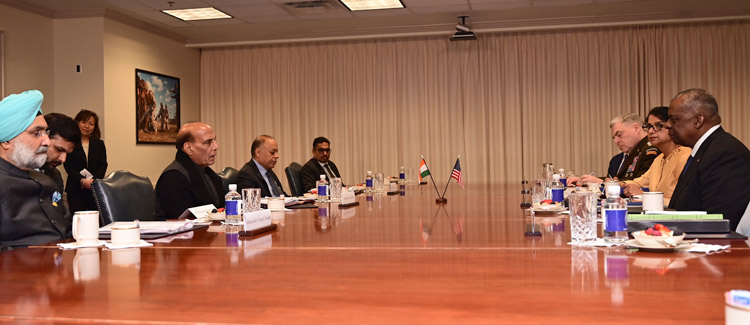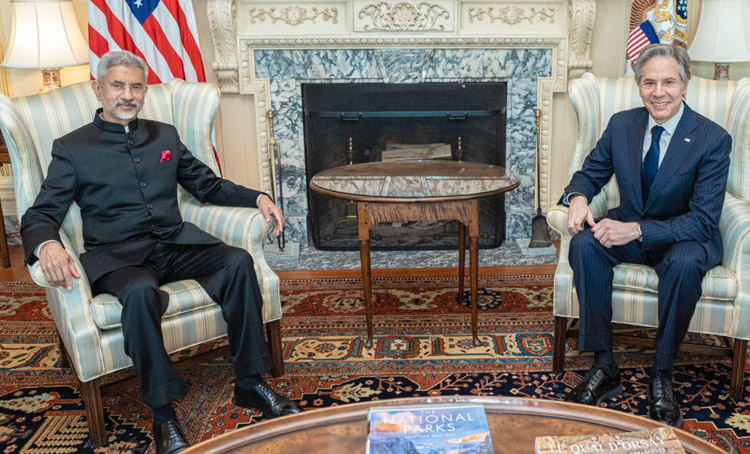INDIAN ARMED FORCES CHIEFS ON OUR RELENTLESS AND FOCUSED PUBLISHING EFFORTS

The insightful articles, inspiring narrations and analytical perspectives presented by the Editorial Team, establish an alluring connect with the reader. My compliments and best wishes to SP Guide Publications.

"Over the past 60 years, the growth of SP Guide Publications has mirrored the rising stature of Indian Navy. Its well-researched and informative magazines on Defence and Aerospace sector have served to shape an educated opinion of our military personnel, policy makers and the public alike. I wish SP's Publication team continued success, fair winds and following seas in all future endeavour!"

Since, its inception in 1964, SP Guide Publications has consistently demonstrated commitment to high-quality journalism in the aerospace and defence sectors, earning a well-deserved reputation as Asia's largest media house in this domain. I wish SP Guide Publications continued success in its pursuit of excellence.
- MoD initiates comprehensive review of Defence Acquisition Procedure 2020, pushes for defence reforms
- G7: The Swansong
- Kalinga Connect: South Asia to Polynesia
- Advanced MRSAM for India for a greater firepower
- Must Credit DRDO for Operation Sindoor, now what is next for defence R&D?
- Operation Sindoor | Day 2 DGMOs Briefing
- Operation Sindoor: Resolute yet Restrained
India-US partnership to challenge China
Prime Minister Modi held a virtual Summit with President Biden on April 11, 2022. With Indo-Pacific in mind and to effectively meet the China challenge, the US administration needs to keep India in good humour. A strong US-Indian partnership is a critical building block in a more resilient regional security architecture.


The outcome of Modi-Biden virtual summit on April 11, 2022 followed by 2+2 ministerial dialogue of foreign and defence ministers have signified the adage of ex-President Barack Obama that India-US relations would prove to be the defining partnership of the 21st century. In spite of serious differences over Russia-Ukraine war, Indian and US leaders have significantly decided to take the relations to newer heights. That President Joe Biden took the significant initiative of holding the virtual summit with Prime Minister Narendra Modi, ahead of the 2+2 dialogue, indicated the importance of the long-term view Biden administration has taken of the India-US strategic partnership in view of the emerging geo-political equations and alliances. The US administration would have proved to be short sighted if they had harped too much on India's refusal to directly name and shame Russia over its military invasion of Ukraine. Significantly the US administration also underplayed India's move to buy oil and gas at a discounted price offered by Russia.
Addressing the India-US virtual summit with @POTUS @JoeBiden. https://t.co/sgYlj2nqSG
— Narendra Modi (@narendramodi) April 11, 2022
I spoke today with Prime Minister Modi of India. We committed to strengthening our defense, economic, and people-to-people relationship to together seek a peaceful and prosperous world. pic.twitter.com/o30ij9reIY
— President Biden (@POTUS) April 11, 2022
With Indo-Pacific in mind and to effectively meet the China challenge, the US administration needs to keep India in good humour. Hence, the high-level engagements in the midst of Russia-Ukraine war, also focussed on the China challenge. Defence Secretary Lloyd Austin did not hide his concerns, when he said, "We all understand the challenges we face in the Indo-Pacific. China is seeking to re-fashion the region and the international system, more broadly in ways that serve its authoritarian interests. India and US can sustain a favourable balance of power in the region." Austin also said that a strong US-Indian partnership is a critical building block in a more resilient, regional security architecture.
That President Biden took the significant initiative of holding the virtual summit with Prime Minister Modi, ahead of the 2+2 dialogue, indicated the importance of the long-term view Biden administration has taken of the India-US strategic partnership in view of the emerging geo-political equations and alliances
On US initiative to hold the Biden-Modi virtual summit before the 2+2 ministerial dialogue, the White House had said that the virtual meeting was aimed to deepen ties between our governments, economies and our people. White House had declared that the two sides will discuss a range of issues relating to Climate crisis, strengthening the global economy, Indo-Pacific security and ending the pandemic.
The outcome of the virtual summit and 2+2 dialogue proves that high level engagements brought a boost to a bilateral relationship that experienced some turbulence because of India's neutral stand on Russian military invasion in Ukraine. Undoubtedly Russia was the elephant in the room but India successfully deflected the pressure from the US leaders to shun India's decision to ignore unilateral sanctions imposed by US and purchase Russian oil and gas at a discounted price. The external affairs minister rightly retorted to a question from media that India's one month import of oil and gas from Russia was equal only to one day import of European oil and gas. Critics found strength in Indian argument that if US can't compel its European allies to stop import of petroleum from Russia, why should India be ignoring its national economic interests. India sidestepped an earlier warning by Daleep Singh, the US Deputy NSA, on his recent visit to India, that Russia will not come to India's rescue in the event of China attacking India. India also ignored the US warnings that there would be consequences for countries who seek to circumvent international sanctions on Russia. However, Indian defence minister Rajnath Singh bluntly told the US interlocutors that New Delhi does not believe in a diplomacy of "zero sum game" and its relationship with one country cannot be at the expense of the other.

Though, during virtual summit and 2+2 dialogue there were familiar assertions about being natural partners, the sword of CAATSA (Countering American Adversaries Through Sanctions Act) still hangs over India's head. India has ignored US threats not to go ahead with the S-400 anti-missile system deal with Russia. Differences over Russia notwithstanding, both sides pressed on with a broad basket of bilateral, regional and international issues of mutual interest. With Indo-Pacific in mind, both sides reaffirmed their dedication to promoting regional stability and prosperity, with an inclusive regional architecture, abiding by the rule of law, the freedom of navigation and over flight, peaceful resolution of disputes, and ASEAN centrality. They also reiterated the importance of adherence to international law to meet challenges to the rules-based order, including in the South China Sea.
Had a wonderful meeting with the US @SecDef, Mr Lloyd Austin at the Pentagon today. We reviewed the entire gamut of bilateral defence cooperation and the regional security situation. pic.twitter.com/HbjLemlMUx
— Rajnath Singh (@rajnathsingh) April 11, 2022
After the virtual summit and 2+2 dialogue, the White House said that both the leaders are committed to strengthen US-India strategic relationship through cooperation on clean energy, technology and military cooperation and expanded people to people and economic ties, besides ensuring free and open Indo-Pacific. They emphasised their shared commitments as leaders of world's largest democracies, to respect for the sovereignty and territorial integrity of all nations in the Indo-Pacific and beyond.
With Indo-Pacific in mind, both sides reaffirmed their dedication to promoting regional stability and prosperity, with an inclusive regional architecture, abiding by the rule of law, the freedom of navigation and over flight
The joint statement issued after the 2+2 talks referred extensively to India-US cooperation and engagements on Indo-Pacific and the four nation QUAD group, and drew attention towards progress made in 2021 on developing a positive and constructive agenda for the QUAD to deliver peace and prosperity to the region in pursuance of their shared vision for a free, open, and inclusive Indo-Pacific. The Ministers reiterated their commitment to take forward the initiatives announced by the Leaders, to empower the QUAD as a force for global good for the Indo-Pacific region and welcomed ongoing discussions in the QUAD Working Groups on vaccines, climate change, infrastructure, space, cyber security, and critical and emerging technologies for delivering practical and tangible benefits to the region.
Taking note of the rebound in bilateral trade to the record level of $160 billion, both sides reviewed measures to expand bilateral trade, remove market access barriers, and improve ease of business. They looked forward to both sides developing action plans that identify and prioritise the resolution of specific trade concerns to build on the progress made during the last Ministerial meeting.

Significantly, both the countries are working on ways and means to reduce dependence on China for critical minerals, components and technology, which will go a long way in cementing strategic partnership for the 21st century. With this aim the ministers reaffirmed the vital role of secure, resilient, reliable, and diverse supply chains for Critical and Emerging Technologies (CET), and the need to enable regional and global innovation. The Ministers decided to put in place a framework to advance cooperation in CET such as advanced communication technology, artificial intelligence, quantum science, STEM, semi-conductors and biotechnology.
Pleased to participate in this conversation with my friend @SecBlinken.
— Dr. S. Jaishankar (@DrSJaishankar) April 13, 2022
The Working Group on Education and Skill Development will further enhance opportunities for #IndiaUS cooperation. https://t.co/hVCXIurOMw
Since previous US administrations played a major role and were instrumental in bringing India in international nuclear mainstream, in the first decade of this century, the two countries are advancing their nuclear cooperation under the US-India Civil Nuclear Energy Working Group and the Global Centre for Nuclear Energy Partnership Joint Working Group. The nuclear agencies of two countries are negotiating for the construction of six nuclear reactors in Kovvada, Andhra Pradesh, India. Both the countries have achieved progress in facilitating opportunities for Westinghouse Electric Company (WEC) to develop a techno-commercial offer for the Kovvada nuclear project. Significantly nuclear experts of both countries are working on a project to develop next generation small nuclear reactor technologies in collaborative mode for the domestic market as well for export. From the US side, the Westinghouse Electric Company (WEC) and Nuclear Power Corporation of India (NPCIL) have been engaged to advance this significant cooperation.
Both the countries are working on ways and means to reduce dependence on China for critical minerals, components and technology, which will go a long way in cementing strategic partnership for the 21st century Besides defence and nuclear sectors, India and US are also developing closer partnership in Space arena, which Secretary Blinken described as a demonstration of growing technology partnership
Besides defence and nuclear sectors, India and US are also developing closer partnership in Space arena. During the dialogue, both the countries signed a significant agreement on Space Situational Awareness, which Secretary Blinken described as a demonstration of growing technology partnership which has virtually limitless potential for exploration, for discovery, for achievement to the benefit of the people of both countries and for the world.
Thus, it is evident that the cooperative relations, developing because of shared strategic interests and democratic values, have deeply expanded from defence and science and technology to nuclear, space and critical technologies, which will be able to showcase to the world the range and depth of bilateral relations. In the backdrop of new emerging geopolitical dynamics, India and US strategic partnership will be a factor in ensuring peace, stability and prosperity in the world. As External Affairs Minister S. Jaishankar correctly remarked, "We can truly assert that there's virtually no domain on which we are not cooperating with each other. The nature of our opportunities and challenges are such that they are more effectively addressed through a cross-cutting dialogue." The latest round of top-level interactions between India and US would help in taking forward the relations to the level of defining partnership of the 21st century, as enunciated by ex-President Barack Obama. This partnership has a huge potential for ensuring peace and stability in the Indo-Pacific region and for the benefit of the people of these two great democracies.





